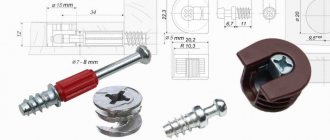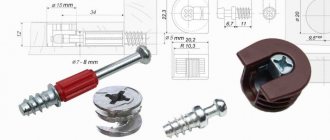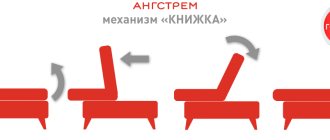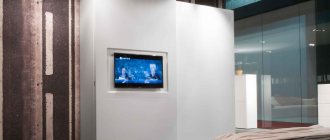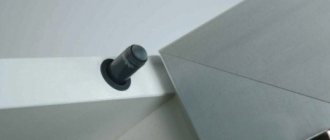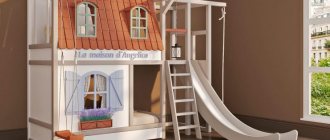Theory of the issue
When a master independently installs a mixer, he is faced with the following problem: the indicator of the distance that separates the pipes through which water is supplied and the same parameter for the corresponding tap pipes do not correlate. This leads to the fact that it is impossible to connect the mixer directly to the pipes.
It is for this purpose that this article discusses the question of what eccentrics are, since such devices, when rotated from one side to the other, allow the master to adjust the distance between two bushings.
Often, designs of this kind are already included in the purchased kit along with the mixer itself, so the installer does not have to “reinvent the wheel” - he just needs to read the instructions and act according to the recommendations specified in it.
It happens, however, that the kit is sold without such devices or the dimensions of the eccentrics are incorrect. In such a situation, you will have to purchase the installation mechanism separately.
Eccentrics included
If the design turns out to be shorter than you would like, you can purchase an additional adapter - it will help adjust the dimensions of the product.
Dismantling
Replacing an eccentric in a bathroom begins with dismantling outdated or unusable equipment. Carrying out the work in this sequence will allow you to correctly select a new device, taking into account all the features of pipe supply and the wishes of the customer.
How to unscrew the eccentric? It is recommended to perform the work in the following sequence:
- shutting off the water supply. If you do not first shut off the flow of water to the mixer, then replacing the eccentrics will lead to flooding of the bathroom and neighbors living on the lower floors;
- disconnecting the shower hose from the mixer;
- dismantling the mixer. To perform this work, it is necessary to loosen the nuts securing the device using an adjustable wrench or wrench of the appropriate size;
Removing the faucet in the bathroom
- removing the reflector - a special decorative device that covers the junction of the pipes and the mixer. The reflector is installed by screwing onto the eccentric. Therefore, to dismantle it, it is enough to unscrew the device;
- dismantling (unscrewing with a wrench) eccentrics.
Unscrewing the device from the pipe
Unscrewing the eccentrics from the pipes must be done extremely carefully so as not to damage the threads on the pipes.
After completing work on removing the eccentrics, it is necessary to clean the walls, pipes and other components from accumulations of dirt, rust and other types of contaminants.
Dismantling and installation of plumbing fittings
To install plumbing equipment, you will need a set of wrenches, FUM tape or tow. Installation of eccentrics for the mixer is carried out in the following order:
- A sealing material is screwed onto the external thread.
- The eccentrics are screwed into the fittings of the water supply system and tightened.
- The position of the free pipe is set so that they coincide with the connecting surfaces of the mixer.
- The plumbing fixture is attached to the pipelines using union nuts.
You can buy a short eccentric for a mixer without any problems and it allows you to quickly perform this operation. This kind of work can be done by any man who has minimal skill in handling tools. Installing the mixer using eccentrics takes no more than half an hour. In this case, the design features of the devices should be taken into account.
When installing a mixer with pipes, you will need an appropriate adapter. An eccentric with an internal thread for the mixer must be purchased in advance so as not to delay the work. Such devices allow the use of sealing gaskets instead of tape. Reliable installation of the mixer using such an element will eliminate the occurrence of leaks from the water supply system.
Installation process
When doing any plumbing repair work, the first step is to shut off the pipes. They do preliminary assembly to check whether all the parts fit together, whether the nuts are easy to screw on, and whether there are any extra parts left. It is necessary to check the installation level, make sure there are no distortions
It is important to pay attention to the length of the arm so that it is sufficient for a strong connection to the mixer. Only after this is the final installation carried out
Flax is wound clockwise onto the threads of the narrower part of the eccentric. You can use another sealant, for example FUM tape
Compliance with the winding direction is important so that it does not slip while twisting the part. When screwing the mixer, you can use the rubber seals included in the kit.
We need to check their presence.
First, the parts are tightened by hand and then clamped with an adjustable wrench. After installation and tightening the nuts tightly, turn on the water and check for leaks. At this point the work can be considered completed. If a crack appears on the adapter and it begins to leak, you can remove the mixer and replace one damaged part. There is no need to change the second one, since they are completely independent.
Installing the structure on the wall
First of all, it is necessary to install the eccentrics correctly. They are usually included in the kit, but can easily be purchased separately, which is recommended if they are not the right length. Procedure
- The eccentrics are screwed into fittings coming out of the wall. Be sure to wind it from FUM tape or strands of flax and plumbing paste. In the latter case, take a strand of flax (about 3 mm thick and about 50 cm long) and wind it onto the thread. The point of winding is to hide the thread under the winding.
- Then plumbing paste is applied to the flax and the eccentric is screwed into the water socket. The paste protects flax from rotting. You can use sealant instead.
- You need to wind the flax in the opposite direction from the direction in which the eccentric will be screwed in so that the fibers do not ride up.
- If you use FUM tape, you must thoroughly clean the threads of dirt and wipe them with gasoline. When winding the tape, apply layer by layer, overlapping the previous one by half, with a slight stretch. Usually 6-8 layers are made. Then the tape is pressed with your fingers until the thread appears.
Eccentrics are necessary so that the structure can be mounted even where the distance between the holes of the mixer and water sockets differs. They make it possible to correct discrepancies of up to 5 mm horizontally and vertically. If one of the water outlets is deeply recessed into the wall, it is impossible to install the faucet on identical eccentrics. Therefore, they select the fittings in this way: screw the long one into the recessed water outlet, and the short one into the one that is less recessed.
When installing eccentrics, it is necessary to maintain a horizontal level. Therefore, when adjusting the tightening of fittings, be sure to check the level. But it is also necessary that the distance between the eccentrics coincide with the axial distance between the mixer leads.
Before installing a new faucet in the bathroom, it is advisable to check the tightness of the created connection. It is clear why it is recommended to do this before installing the housing: so that you do not have to remove the tap later if a malfunction is detected. It is convenient to use plugs with rubber gaskets for this purpose. They are installed on eccentrics and the water supply is turned on. If there is no leak, proceed to installing the mixer:
- The gap between the water sockets and the tiles is sealed with silicone sealant so that water getting behind the reflectors does not flow under the tiles.
- Mount decorative cups. They are threaded and screw onto the external thread of the eccentrics.
- Install mesh gaskets into the nuts and screw the mixer into place. Moreover, the smooth side of the gasket should be pressed against the eccentric, and the ribbed side against the nut. First tighten the nuts by hand, and then use an adjustable wrench to do this. Tightening must be done carefully so as not to cut the gaskets. Place a rag between the nut and the key, otherwise scratches will remain on the nuts.
- Correct installation assumes that the nuts completely hide the eccentrics, but it happens that the fittings are visible. If this does not suit you, you can shorten the eccentrics with a grinder, choose a shorter eccentric or a deeper reflector cup. Cups differ not only in depth, but also in diameter. Larger diameter reflectors help hide chipped tiles.
- Then the rain hose is screwed to the mixer using a nut, and the shower head is attached to the cone-shaped nut. Gaskets are pre-inserted on both sides.
- The gander is screwed in the same way.
You should flush the pipes before installing the aerator to remove dirt from the pipes. After its installation, the installation of the mixer is considered complete.
Removing the faucet installed on board
To remove the old faucet, it is enough to turn off the water, unscrew the flexible hoses from the water intake points and one or two nuts that secure the faucet to the side of the plumbing fixture. After this it can be easily removed.
What you need to know
The nuts have a chrome-plated surface, which is easy to damage when fixing, so it is advisable to apply a soft cloth to them when tightening.
Sometimes, after fixing the nuts, the reflectors themselves leak; in this case, it is necessary to install an additional gasket or replace it with a thicker one. In this case, you should not apply excessive force; it is enough to tighten until slight resistance appears, since gaskets made from modern materials are highly airtight and do not require strong compression.
In order to simplify further installation, the shower hose should be secured to the structure before its installation. Fixing the shower head does not require the use of special tools; it is easy to screw it on by hand.
The gander itself has two gaskets inside the structure; all that remains is to connect the attachment points and tighten the threaded connection. As noted above, do not over-tighten the threads to avoid damaging the gasket.
Installation of equipment
Installation of new eccentrics is carried out in two stages:
- at the first stage it is necessary to attach the adapter to the pipes;
- at the second stage - connecting the adapters to the mixer.
Attaching the eccentric to the pipes
To attach the device to the pipes you will need:
- keys of appropriate sizes;
- insulating material, which can be linen thread, a special compound, FUM tape, and so on.
Installation is carried out according to the following scheme:
- determining the optimal position of devices for connecting the mixer. At this stage, it is necessary to calculate the number of eccentric revolutions that must be made for correct installation of the equipment;
- fitting of a mixer;
- insulation of threads using the selected material;
Thread sealing with linen thread
- installation of the eccentric.
To protect the eccentric coating when tightening the device with wrenches, it is recommended to use a gasket or union nut.
Attaching the mixer to the eccentric
The final stage - installation of the mixer is performed as follows:
- installation of decorative reflectors;
- installing the gasket. The gasket protects the junction of the adapter and the mixer from leakage;
Insulating the connection between the eccentric and the mixer
- connecting the mixer and shower hose;
- checking the functionality and sealing of the formed connections.
The entire cycle of work on replacing eccentrics yourself is presented in detail in the video.
Thus, replacing eccentrics on your own does not cause problems even for novice craftsmen. The main thing is to choose the right device.
Final Conclusion
From the entire article we can conclude that it is impossible to install the mixer without the use of eccentrics. No specific skills are required during the installation process, so you can do it yourself. The main thing is to choose the right types of eccentrics for the mixer, use sealing tape, and install silicone, rubber or nylon gaskets.
You also need to ensure that the mixer is installed correctly, which should be in the zero horizontal position. All stages are completed by checking the components for water leaks. If necessary, they need to be tightened. If you follow the instructions and follow all the above tips, then everything will work out the first time.
Sources
- https://FB.ru/article/183288/zamenyaem-ekstsentrik-dlya-smesiteley
- https://santehnika.guru/aksessuary/ekstsentrik-dlya-smesitelya.html
- https://ProSmesiteli.ru/ekscentrik-dlya-smesitelya/
- https://dizain-vannoi.ru/vidy-ekscentrikov
- https://otopleniedomov.com/santekhnika/ehkscentriki-dlya-smesitelya-demontazh-i-ustanovka.html
- https://santehnicheskij-mir.ru/santexnika/ekscentrik-dla-smesitela.html
- https://dekoriko.ru/vannaya/smesiteli/vidy-ekscentrikov/
- https://kakpostroit.su/ekscentriki-dlya-smesitelya-razmery/
[collapse]
Similar posts:
- How realistic is it to do without eccentrics?
- Three options for mounting a ball valve on…
- Do-it-yourself plumbing in the country: how to choose pipes,…
- Standards for the height of a bathroom vanity cabinet, as...
- How to make a hole for a faucet in a stainless steel sink?
- How to paint polypropylene pipes: choice...
Installing eccentrics and mixer
Using the detailed instructions included with the product, you can easily figure out how to install the eccentrics for the mixer; it’s not difficult. First of all, the flax or fluoroplastic thread should be wound carefully and as tightly as possible along the thread. Apply silicone sealant or oil paint on top of it; it is permissible to use a paste intended for threaded connections. However, this action is desirable, but not required.
The eccentrics must first be installed manually, carefully observing that there is no misalignment. Only after making sure that the connection being made is high quality can you use a wrench or adjustable wrench for final tightening. The eccentrics should be level and without distortion, and their position should ensure a convenient connection with the mixer nuts. It is best to check horizontality using a level. The included decorative screens are screwed on by hand.
Often paronite, silicone or ordinary rubber gaskets are included with the purchased plumbing product. When using the first type, it is recommended to soak them in cold water for a few minutes before use. First, you should “bait” the mixer by carefully tightening the nuts by hand. After making sure that there is no distortion and that the threads are well threaded, use an adjustable wrench to tighten the nuts to the end.
How to choose a quality product
When replacing an old faucet, most often you can’t do it without the help of eccentrics. Often, inexpensive Chinese or Turkish products come with chrome-plated adapters, the quality of which is highly questionable. These shiny, attractive parts have a lot of undesirable properties - rust appears on the threads during use, and an unreliable head can break during installation. It is best to purchase brass, but first make sure that it is solid cast.
An attractively priced adapter made of pressed brass is highly fragile and can fail at any moment, falling apart. The weight of the purchased product can serve as a guide when purchasing. Brass adapters are much heavier, and their cost is higher.
The golden color of the product cannot serve as evidence, since sometimes a completely different material appears under the coating layer.
Also interesting: when arranging a bathroom, do not forget about showers in Krasnodar online store https://santi.su/. Only high-quality materials at affordable prices!
Reflectors for heated towel rails
The reflectors are made in such a way that their internal diameter coincides with the thread diameter. But they rarely have to be put on the thread itself. Much more often - on the very surface of the extension cords. Therefore, 3/4" collapsible reflectors fit perfectly into the outside diameter of 1/2" threaded extensions. But to fit them onto 3/4″ threaded extensions, you need to trim and fold the inner edge slightly, as in the photo.
This is done with metal scissors and pliers with thin jaws. Try not to unnecessarily bend the thin edge of the junction of the two halves of the circles. It will withstand two or three bends, but no more, and with a high degree of probability it will break.
This is what happened in the end. Heated towel rail with eccentrics and reflectors.
Choosing a new eccentric
When choosing new eccentrics, the following parameters should be considered:
- Material:
- The most common are eccentrics made of brass. They are characterized by low cost, corrosion resistance and durability in the absence of external mechanical influences;
- It is recommended to purchase solid brass products. Eccentrics can also be made of bronze, copper and other alloys. The use of such devices is advisable when installing a mixer and pipes made of similar materials.
- Adapter sizes:
- a short eccentric, 3–4 cm long, is capable of leveling a gap whose size is no more than 8 cm.
- an elongated eccentric 4–5 cm long is selected when the gap is 8–10 cm.
- a long adapter (more than 5 cm) is installed to equalize larger gaps or the need to move the mixer higher or lower relative to a given level.
If the installation of the mixer does not require displacement of the pipes, then a straight eccentric is installed.
Types of eccentrics depending on size
- Input diameters. The standard cam has a diameter of ¾ inch for connecting the device to water pipes and ½ inch for connecting the device to the faucet. On sale you can also find products with other sizes in accordance with similar parameters of pipes and mixer.
Eccentric with standard parameters
Materials from which eccentrics with nuts are made
The production of eccentrics makes it possible to use the same materials from which the mixers are made, and therefore most often they buy such components in a ready-made kit: if the faucet is made of copper, then the eccentrics are the same. Popular materials used for the manufacture of plumbing components:
The initial work that should be done is to turn off the water so that it does not interfere with all subsequent actions. After shutting off the water, the following manipulations are carried out:
- If a new adapter is installed in place of the old one, after unscrewing the part, the place of the thread in the wall must be cleaned and freed from accumulation of dust and dirt.
- The eccentric is inserted into the cleaned area without packing the threads yet.
- When tightening the threads of one adapter without packing, you need to count the number of full turns that were required before it was completely screwed in. To measure, you first need to draw dashes at the same distance near the first and second eccentrics to start counting the rotation. The distance between such lines should be exactly 15 cm - the plumbing standard when installing a mixer and, accordingly, the parameters that are taken into account during its manufacture. The mark on the adapter itself is also a special dash; if it is not there, you can draw it with a marker.
- After screwing both adapters, place any flat surface on their surface to determine the presence of gaps. For example, you can use any wrench, placing it on the plane on the side where the eccentrics exit. If the key does not wobble and there is no gap between them, you can continue to carry out work. If there is a gap, check that the thread is screwed in evenly.
- We apply the mixer and check whether the dimensions of the adapters now exactly match.
- After all the work has been completed, you can again remove the mixer and unscrew the adapters. Now the task is to fit the eccentrics tightly, so that they do not wobble when the tap is pressed.
- After unscrewing the eccentric, you need to wrap Teflon tape or thread on one side of it. We twist it back, remembering the number of revolutions. For example, one adapter rests on the mark at 4 revolutions, and the other at 5.5.
- Lubricate the wound Teflon tape with drying oil and screw it into the thread in the wall the required number of turns.
- After several turns by hand, the thread will not go any further. Therefore, it is worth screwing a nut onto the top so as not to damage the thread for fastening the mixer, and make the required number of turns using a gas wrench.
- We carry out similar manipulations with the second eccentric.
- Decorative shields are screwed on.
- Gaskets are placed on the threads on the mixer side.
- The thread is put on and the mixer is connected to the adapters.
- Tighten the nuts on the faucets with a wrench until they are fully seated and fit snugly against the wall.
- Water leakage is checked.
At these stages of installation, all work is completed, all that remains is to use the mixer without worrying about water leakage outside the mixer.
Consecutive stages of work
The next operation is to manually screw the long eccentrics to the structure. Make sure that the device is correctly aligned with the thread itself, only then screw it tightly using an adjustable wrench or wrench. It is better to perform several successive rotational movements with the tool. Carefully check that the flax threads that were wound directly onto the threads do not wrap around - this will disrupt the functionality of the entire structure. If this still happens, it is better to dismantle the entire system, remove any remaining flax from the threads, and then re-wrap it with a sealant.
After the faucet is installed, you can proceed to the installation of reflectors, which are also called decorative screens.
How to install eccentrics for a heated towel rail
First of all, make sure that you buy eccentrics with the correct thread. Such that they fit into the thread of the heated towel rail and the tap with the “American” on the riser outlets. And if the threads do not match in size or “inside-outside,” then find the necessary adapters.
Now measure the distance between the taps on the riser and tighten the eccentrics (without any sealing material for now), setting the measured cm and mm. between them. Place the heated towel rail in place and lightly tighten the nuts. If you are satisfied with everything, then stick masking tape at the junction of the eccentrics and the threads of the heated towel rail and make marks with a pencil. This is necessary in order to return to the desired position when assembling the structure with flax or other sealant. Now cut the tape along the joint with the blade of a knife, disassemble the connection and begin a new assembly with sealing the threads.
Where you see a big beautiful nut on the eccentric, flax is not needed. The nut has a gasket that connects perfectly with the “American” valve.
By the way, if the riser itself is not strictly vertical, then eccentrics can solve this problem. It is only necessary, when winding them, to make the necessary deviations from the vertical in the opposite direction.
If the heated towel rail is located too close to the wall, then the eccentrics will allow you to slightly increase this distance. But only if the heated towel rail itself is parallel to the wall. If this is not the case, then you can fix the problem as described in the article about the heated towel rail riser.
Another point that is often neglected is the installation of chrome extensions in front of the riser valves. They are nicer than metal pipes or polypropylene pipes sticking out of a tiled box. In addition, you can attach collapsible reflectors to them, which will hide the hole in the tile.
What is an eccentric in entrance doors
An eccentric is a simple mechanism used to adjust the tightness of the valves. It is located at the end of the structure, where it adjusts the position of the lock latch bolt relative to the frame profile, preventing the door leaf from deflecting. This helps to avoid problems with unlocking and locking locks and the sash not closing tightly, and also keeps the entrance structure from sagging.
A metal cylinder with an offset center of gravity is secured in the desired position with a locking screw, which makes it possible, if necessary, to easily adjust the degree of fit of the blade using a screwdriver. Due to the difference in eccentric positions, adjustment is possible within 4-5 mm.
There are models with a plastic cylinder. They also effectively solve the problem of misalignment, but the wear rate of plastic structures is higher than that of metal ones due to the lower strength of the material. Such mechanisms require regular, timely replacement with new ones.
Modern steel doors are equipped with metal eccentrics.
The problem of displacement of the shutters relative to the frame and subsequent distortion of the structure is faced mainly by owners of inexpensive models of door structures.
But manufacturers have already developed models of steel doors equipped with this mechanism. In them, the eccentric is placed at the end, the cylinder is located in the box, and the pin is placed in the canvas.
Eccentric for mixer: installation features
Despite the apparent simplicity of installing such a mechanism, its installation should be carried out with extreme care and precision. The whole process consists of two stages:
- Fastening the structure.
- Mixer connection.
Before you begin work, you need to turn off the water to avoid flooding your neighbors.
Next, it is recommended to assemble the structure without using a seal - this stage is needed to ensure that there are no distortions in the assembled product, as well as difficulties in connecting individual elements to each other. If the parts are too short, they should be replaced with elongated eccentrics for mixers, or additionally purchase special screens for such structures.
Separately, it is necessary to say about the dismantling of the old eccentric
It is important to unscrew it as carefully as possible, after which you need to wrap the short thread with flax or fluoroplastic tape. Any of these products must be wound very tightly to prevent the material from twisting around the base.
After this, a special paste should be applied to the winding, which makes working with threaded connections easier, or silicone sealant. If these materials are not available, you can use regular oil paint. In the worst case scenario, this step can be skipped.
What follows is a delicate operation, which is important to be treated with the utmost care.
It is important to install the eccentric mixer carefully and only by hand. This will avoid possible distortions in the structure.
Only after the correct relationship between the device and the thread has been checked, the eccentric can be tightened more tightly using an adjustable wrench or wrench.
This will avoid possible distortions in the structure. Only after the correct relationship between the device and the thread has been checked, the eccentric can be tightened more tightly, using an adjustable wrench or wrench.
In this case, it is necessary to constantly check that the linen threads previously wound on the thread do not twist. Since in this case the functionality of the entire structure as a whole may be impaired.
If a problem with flax does arise, you should completely dismantle the installed equipment and repeat the entire procedure again, starting with the thread winding stage.
After installing the crane, you can install special reflectors - decorative screens.
The use of eccentrics for different types of mixers and their sizes
It is to facilitate the tasks of installing plumbing that such devices are used.
According to the principle and purpose, these are adapters that have offset axes with threaded parts 3/4″x1/2″ (15x20 mm). One end is screwed into the water supply, and one of the pipes of the plumbing product is attached to the other. The material used is usually brass or bronze. According to standards, the center-to-center distance between the pipe inlets is 150 mm. In cases where this parameter is slightly mismatched, simply turning the adapter can achieve complete alignment. Thus, with the help of eccentrics, you can adjust the dimensions of any mixer to the pipes established according to the standards.
Sometimes “crooked” plumbers or maybe tilers make the standard size of 150 mm a little smaller. In this case, a regular adapter with an arm length of 40 mm will not help and you will have to look for a product of a different model in specialized stores. Manufacturers have taken care of the common consumer here too; if desired, you can find the following shoulder sizes by center:
- 40 mm;
- 60 mm;
- 80 mm.
A faucet from a reputable manufacturer always comes with a 40 mm eccentric along with decorative reflectors that will neatly cover the hole in the tile made during construction. Depending on the length of the arm, a reflector of the appropriate diameter should be installed to completely cover the hole and adapter.
What do you need to know before installing a faucet in the bathroom?
Practically, all mixers have a connecting size of 1/2 inch and a distance between the axes of the tubes of 150 mm plus or minus 15 mm (see diagram below). These dimensions should be taken into account when installing the pipeline, and be sure to measure these distances from the mixer purchased in advance.
If the mixer is rotary, then we choose a place to install the mixer, also taking into account the rotation:
The height of the mixer from the finished floor is 120 cm.
However, you can determine the location for the faucet above the bathtub as follows: temporarily place the bathtub in the place where it should be. Then we draw a line on the wall vertically upwards exactly in the center of the bathtub, select the desired height, usually no more than 30 cm. We drill two holes with a center-to-center distance of 150 mm:
Holes are needed if you need to bring hot and cold water pipes from a room located behind a wall (partition) to the mixer; this is the layout in most apartments where the bathroom and toilet are separated by a wall. Usually the risers are located in the toilet, and the tubes go into the bathroom from there. If you have everything in one room (say, an old apartment with a shared bathroom or a private house where the bathroom is also shared for some reason), then, most likely, you don’t need to drill through the wall. I am hinting that you should proceed from your own situation and not blindly copy. But since this article is only about installing a faucet in the bathroom, I will not tell you here how to install a water supply from different pipes, but will continue on the topic of the article.
The mixer kit includes gaskets, eccentric bushings and decorative cups:
Completing the faucet installation
Well, now, after everything I’ve written, I’m sure that, despite possible difficulties, you still installed this device as it should. Now it's a matter of small things. Take the mixer in your hands, insert the spacers and align its nuts with the eccentrics. Tighten the mixer nuts evenly. To avoid damaging the chrome surface of the nuts, use a soft cloth between the wrench and the nuts as a spacer.
If you tighten the nuts all the way to the reflectors, but a leak occurs in this place when water is supplied, then install thicker gaskets or use two at once. This will solve the problem. But there is no need to press the gaskets with all your might. This can damage them, which will also cause leakage. Unfortunately, I cannot describe to you in words here the degree of effort at which you should stop. I’ll just write that you don’t need to hang on the key with the entire weight of your body, you just need to feel a little resistance. The gasket is rubber, easily dented and very airtight.
Other parts of the mixer
The design of some faucets is such that it is better to screw the shower hose to the faucet before you install the faucet itself. Otherwise, the proximity of the tile surface may interfere with your work. Think about this in advance and do so if necessary.
Well, then it’s just the little things. Screw the shower head to the hose. Basically, you don't need a key to tighten it. The effort of your hands is enough.
And finally, the gander himself. Look carefully at the picture. Two gaskets are already installed inside the gander. You should only use a little effort to align the fastening points and, having felt the course of the thread, tighten it. Again, without fanaticism. All threaded connections with gaskets should not be over-tightened. Such excesses in the application of energy are likely to damage the gasket. If you feel a slight resistance, you should immediately stop twisting.
Now you can turn on the water supply and check all connections. If suddenly a small leak occurs in places where there are gaskets, you should tighten the nut 3/4 of a turn and make sure that everything is in order and the mixer is ready for use.
Types of eccentrics
The eccentric is actually an adapter that simplifies the installation of the mixer. In some cases, these installation elements are included in the crane kit, in other cases, you have to buy them. The second option is preferable; the delivery package does not always correspond to the ideas of the apartment owners or the features of the pipeline that was inherited.
Bronze eccentric
If there is a shortage, it is often necessary to lengthen the eccentric for the mixer; this can be done using additional adapters, but it is better to use extended models. They look more aesthetically pleasing and do not allow the appearance to be spoiled by not very conscientious plumbers who do not pay any attention to aesthetics. There is a wide variety of models on the market; Grohe offers a very wide range. The proposed options are really enough to solve a number of problems.
Adapters are usually divided (pictured):
- elongated, used when it is necessary to “move” the faucet away from the wall or lower it below the level of the pipes; for this you only need to unscrew and screw additional elements;
- short ones are used for standard installation; differences in length up to 80 mm are compensated.
Extended eccentric
Also offered are adapters with a socket and in a housing, used for installing expensive plumbing fittings. When selecting, you need to comply with the types of fastening, for example, “father-mother”, “mother-mother”. This refers to the type of internal and external threads, as well as fastening. Of particular interest are the extended adapters. They allow you to install a valve below or above the entry point into the pipeline without carrying out additional major plumbing work.
When might this be needed? For example, if you installed a lower sink, or you don't like water splashing from the faucet into the bathtub. Using long adapters you can make an aesthetic connection. Such eccentrics for the bathroom faucet are made in chrome or gold; they look like part of the structure, which can be unscrewed and replaced at any time with a traditional design.
Installing an eccentric coupler
Let's look at how an eccentric screed is used using the example of a countertop and a cabinet. An example of the use of an eccentric coupler is a desk, or any case where it is necessary to connect two parts in a hidden way.
An eccentric coupler consists of two parts: a rod and an eccentric. The rod is installed in one part, and the eccentric in another.
Fig.2.
To install the eccentric coupler, you need to drill several holes. In one part, a blind hole is made for an eccentric with a diameter of 15 mm and a depth of 12.5 mm (the distance between the center of the hole and the end of the part is equal to the length of the rod), as well as a hole for a rod with a diameter of 8 mm (the distance between the center of the hole and the surface of the part is 8 mm). In another part, a blind hole with a diameter of 5 mm and a depth of 12 mm is made for installing the rod.
The installation of the eccentric coupler begins with markings. Before marking the parts, you need to know the installation size. In the example below, the installation dimension is 26 mm. You can find out the size either on the packaging, or upon purchase, or by measuring the stem. From the head to the beginning of the thread.
Marking the holes for the eccentric coupler
It is convenient to do the marking as follows. It is necessary to place the parts to be connected on top of each other, and mark the location line of the eccentric coupler.
Fig.3.
It is convenient to make markings on both parts being connected at once. The position of the rod relative to the front or rear end of the part is marked on the parts (usually 5-7 cm). On the part in which the eccentric will be installed, mark the center of the hole along the eccentric.
In the photo, two parts are connected at once, so I did the markings at the same time.
Next, on the part where the eccentric will be installed, the center of the hole for it is determined. In the photo above, this is a horizontal serif. The length of the segment is the installation dimension equal to 26 mm.
Hole drilling tool
After the markings are made, it is necessary to drill all the holes. The holes on the tabletop are made with a regular drill with a diameter of 5 mm. It is convenient to use special wood drills. Using a similar drill only with a diameter of 8 mm, a hole is drilled in the end of the mating part.
In order to make a sample for the eccentric, a special Forstner drill is needed. These special drills come in different diameters, so for high-quality installation of the eccentric, you should purchase a drill with a diameter equal to the diameter of the eccentric.
Fig.4. The hole for the eccentric is made with a Forstner drill with a diameter of 15 mm
Here it is important to accurately observe the depth of the hole. Traditional hole depth 12.5 mm
You can maintain the depth of the hole using a drilling depth limiter.
Using this drill, we make a hole with a depth equal to the thickness of the eccentric, which is about 12.5 mm.
Fig.5.
After the hole for the eccentric is ready, drill a hole with a diameter of 8 mm for the rod. The order of drilling the holes is important, so drilling a hole too deep for the rod will not allow the hole for the eccentric.
Examples of using an eccentric coupler.
Fig.6.
Fig.7.
Fig.8.
Selecting the right model
To purchase a suitable part, you need to know the distance between the pipes and the parameters of the mixer. If the difference in distances is significant, then it is worth buying an extended eccentric with the largest shoulder. Such parts are usually not included in the kit.
The diameter for connecting pipes is 1/2 or 3/4 inches, so the eccentrics fit all standard water pipes. Very rarely there are unusual shapes of products that require an individual approach.
For plastic pipes, the metal of the adapter does not matter, but for metal pipes it is desirable that the materials match. This ensures equal thermal expansion and response to internal water pressure, ultimately eliminating leaks. In any case, with ordinary steel pipes, experts advise choosing brass or bronze products - this will be the best option. Brass adapters must be solid.
Unscrupulous manufacturers spray metal of poor quality, passing off parts as more expensive. With constant contact with water, they quickly break down, fail, and leaks begin. To avoid mistakes, you need to buy eccentrics from suppliers you trust, or contact specialized brand stores.
Tips and tricks
If your pipeline is made using plastic pipes, then the material of the eccentric in most cases will not matter. But in the case of using metal pipes, it is important to ensure that the fitting is made of exactly the same metal, otherwise, due to different values of the coefficient of thermal expansion, the reliability of the connection will decrease over time, which can lead to leakage.
When installing chrome-plated eccentrics, it is worth wrapping them in several layers of fabric while tightening them to prevent damage to the chrome layer, because even a small crack in the protective layer can lead to rapid corrosion of the metal underneath and the need to replace the product.
It is best to purchase a product made of cast brass - this allows you to simultaneously maintain the high strength and elasticity of the material, which reduces the chances of it being damaged during installation.
Installation options and features
Installation of eccentrics is no different from the usual installation of a mixer; they are screwed on with ordinary plumbing tools. On sale you can find more expensive models with anti-leak gaskets. Branded adapters are distinguished by high-quality metal and precise sizing, as well as excellent thread cutting. They do not burst when screwed with excessive force.
Brand catalogs are distinguished by a wide range of options that allow installation for any pipeline shortcomings.
Moreover, the design of the connecting elements gives an additional external effect and makes it possible to:
- place taps at a convenient distance from bathrooms and sinks;
- versions with extensions help lower the faucet below the usual level or container for drawing water;
- unscrew the tap with minimal effort;
- correct deficiencies in pipeline laying without compromising the overall aesthetics.
The advantages of branded models, as already mentioned, include a large assortment of sizes, types, coatings and designs; the variety and capabilities can be assessed even from the photo. When a small addition to a bathroom faucet can make the connection aesthetically pleasing and convenient, this is a very important selection factor. Features of installation of short and long adapters can be seen in the video.
Design and coatings
Continuing the theme of design, it should be noted that companies producing accessories for expensive brands offer various design and coating options. Adapters can be made in chrome, brass, gold and copper, and have a matte or glossy finish. The Grohe brand is distinguished by a wide variety of models that are suitable for both expensive and budget plumbing fittings.
Appearance and characteristics
By rotating the eccentric in a circle, you can achieve perfect joining of the pipes with the mixer pipes. In other words, it acts as an adapter, helps ensure a reliable connection and makes the installation process easier. Using this part, you can install faucets from a variety of manufacturers in the bathroom, toilet, and kitchen.
Often these parts are included in the faucet kit and are listed in the installation instructions. If they are not available, then it is easy to find such products for sale separately.
The eccentric parameters that people pay attention to are the following:
- manufacturing material. The part is made of bronze, brass, stainless steel, and very rarely copper;
- shoulder size. Shows how much the cylinder axes are shifted relative to each other, maybe 40, 60, 80 mm;
- the presence or absence of an internal thread on one of the sides (the thread can only be external);
- eccentric length. It comes in standard (short) and long.
Some manufacturers, for aesthetic purposes, coat the adapter with decorative paint that imitates gold, silver or copper, but this does not affect the quality. The devices are designed for a distance between pipes of 150 mm. Prices vary depending on the manufacturer and the material used. Sometimes the differences in cost are significant, so you need to carefully study the store offers.
How to choose?
Faucet eccentrics are a necessary element when installing a faucet in a bathroom. Extensions of this type allow you to securely attach the product, regardless of the location of the water outlets.
When buying an eccentric for a mixer, you need to consider certain factors.
- Hole sizes. Today, some types of mixers have non-standard connection outlets. Standard models are equipped with external threads, but there are also devices with internal threaded systems. The diameters of the pipes may also not match, which is important to pay attention to.
- Distance between mixer outlets. This factor is one of the most important. For standard situations, an eccentric with a shoulder of 40 mm is sufficient. But if the distance between them is much more than 150 mm, then you need to select larger models that are suitable for your situation.

